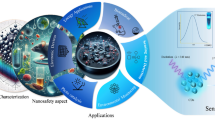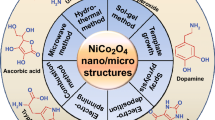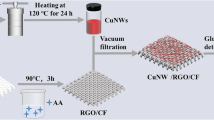Abstract
Although evolving technology enables the production of sensors with excellent properties, the development of a fast-response, portable, and low-cost sensor is very important for food detection and also for disease diagnosis. Herein, zinc doped manganese oxide nanocomposites (Zn:MnO2 NCs) were designed as smartphone-integrated colorimetric and non-enzymatic electrochemical sensors with high sensitivity and selectivity. According to the Transmission electron microscopy (TEM) results showed that the Zn:MnO2 NCs had a spherical shape with a uniform particle size of less than 10 nm. As one of the most important results, the colorimetric sensing behavior of the Zn:MnO2 NCs was showed excellent fast and selective sensitivity against dopamine, ascorbic acid, gallic acid, and tannic acid among the various bio-analytes such as sugars, amino acids, hormones, and phenolic compounds. The Zn:MnO2 NCs were successfully used as smartphone supported paper based sensor against dopamine, gallic acid, and tannic acid using RGB analysis and with low limit of detection (LOD) values of 2.89, 3.88, and 7.81 μM, respectively. Moreover, Zn:MnO2 exhibited excellent a non-enzymatic electrochemical sensor performance against ascorbic acid with a low LOD of 239 nM and high sensitivity of 44.73 μA/cm2 mM in a concentration range of 0.52–11.35 mM. These findings emphasize that the designed Zn:MnO2 NCs based sensors has a potential as easily applicable and rapid sensor systems against of ascorbic acid, gallic acid, tannic acid and dopamine for real food and blood samples that as a point-of-care detection systems.









Similar content being viewed by others
Data availability statement
All data underlying the results are available as part of the article and no additional source data are required.
References
D.P.S. Negi, Recent developments in the colorimetric sensing of biological molecules using gold nanoparticles-based probes. Talanta Open 6, 100122 (2022). https://doi.org/10.1016/j.talo.2022.100122
C. Cong, K. Bian, X. Zhang et al., Sensitive measurement of tumor markers somatostatin receptors using an octreotide-directed Pt nano-flakes driven electrochemical sensor. Talanta 208, 120286 (2020). https://doi.org/10.1016/J.TALANTA.2019.120286
J.M. Liu, X.X. Wang, L. Jiao et al., Ultra-sensitive non-aggregation colorimetric sensor for detection of iron based on the signal amplification effect of Fe3+ catalyzing H2O2 oxidize gold nanorods. Talanta 116, 199–204 (2013). https://doi.org/10.1016/J.TALANTA.2013.05.024
A. Alaghmandfard, O. Sedighi, N. Tabatabaei Rezaei et al., Recent advances in the modification of carbon-based quantum dots for biomedical applications. Mater. Sci. Eng. C 120, 111756 (2021). https://doi.org/10.1016/J.MSEC.2020.111756
A. Serafin, C. Murphy, M.C. Rubio, M.N. Collins, Printable alginate/gelatin hydrogel reinforced with carbon nanofibers as electrically conductive scaffolds for tissue engineering. Mater. Sci. Eng. C 122, 111927 (2021). https://doi.org/10.1016/J.MSEC.2021.111927
Q. Dong, H. Ryu, Y. Lei, Metal oxide based non-enzymatic electrochemical sensors for glucose detection. Electrochim. Acta 370, 137744 (2021). https://doi.org/10.1016/J.ELECTACTA.2021.137744
Lopez A, Liu J (2022) 2021, 93, 3018−3025 Anal. Chem. 2021, 93, 3018−3025 Downloaded via ISTANBUL UNIV-CERRAHPASA on. Anal Chem 10:57. https://doi.org/10.1021/acs.analchem.0c05062
D. Gao, X. Yang, P. Teng et al., On-line SERS detection of adenine in DNA based on the optofluidic in-fiber integrated GO/PDDA/Ag NPs. Sens. Actuat. B Chem. 332, 129517 (2021). https://doi.org/10.1016/J.SNB.2021.129517
A.R. de Brito, R.S. de Jesus, C. de Tavares IM et al., Application of the electrochemical biosensor in the detection of lactose in skimmed milk. Surf. Interf. 22, 100839 (2021). https://doi.org/10.1016/J.SURFIN.2020.100839
D. Manoj, S. Rajendran, T.K.A. Hoang, M. Soto-Moscoso, The role of MOF based nanocomposites in the detection of phenolic compounds for environmental remediation—a review. Chemosphere 300, 134516 (2022). https://doi.org/10.1016/J.CHEMOSPHERE.2022.134516
P. Mohankumar, J. Ajayan, T. Mohanraj, R. Yasodharan, Recent developments in biosensors for healthcare and biomedical applications: a review. Measurement 167, 108293 (2021). https://doi.org/10.1016/J.MEASUREMENT.2020.108293
G. Mi, M. Yang, C. Wang et al., A simple “turn off-on” ratio fluorescent probe for sensitive detection of dopamine and lysine/arginine. Spectrochim. Acta. Part A Mol. Biomol. Spectrosc. 253, 119555 (2021). https://doi.org/10.1016/J.SAA.2021.119555
C.O. Chikere, E. Hobben, N.H. Faisal et al., Electroanalytical determination of gallic acid in red and white wine samples using cobalt oxide nanoparticles-modified carbon-paste electrodes. Microchem. J. 160, 105668 (2021). https://doi.org/10.1016/J.MICROC.2020.105668
J. Liu, Y. Chen, W. Wang et al., “Switch-On” fluorescent sensing of ascorbic acid in food samples based on carbon quantum dots−MnO2 probe. J. Agric. Food Chem. (2015). https://doi.org/10.1021/acs.jafc.5b05726
M. Chowdhury, F. Cummings, M. Chowdhury, Binderless solution processed Zn doped Co3O4 film on FTOf or rapid and SelectiveN on-enzymatic glucose detection. Electroanalysis 29, 578 (2017). https://doi.org/10.1002/elan.201600440
Y. Liu, X. Zhang, L. Luo et al., Self-assembly of stimuli-responsive Au-Pd bimetallic nanoflowers based on betulinic acid liposomes for synergistic chemo-photothermal cancer therapy. ACS Biomater. Sci. Eng. 4, 2911–2921 (2018). https://doi.org/10.1021/ACSBIOMATERIALS.8B00766/SUPPL_FILE/AB8B00766_SI_001.PDF
Y. Soda, E. Bakker, Quantification of colorimetric data for paper-based analytical devices. ACS Sens. (2019). https://doi.org/10.1021/acssensors.9b01802
X. Liu, Z. Chen, R. Gao et al., Portable quantitative detection of Fe3+ by integrating a smartphone with colorimetric responses of a rhodamine-functionalized polyacrylamide hydrogel chemosensor. Sens. Actuat. B Chem. 340, 129958 (2021). https://doi.org/10.1016/J.SNB.2021.129958
L. Engel, I. Benito-Altamirano, K.R. Tarantik et al., Printed sensor labels for colorimetric detection of ammonia, formaldehyde and hydrogen sulfide from the ambient air. Sens. Actuat. B Chem. 330, 129281 (2021). https://doi.org/10.1016/J.SNB.2020.129281
A. Sani, M. Khezerlou, A. Ehsani et al., Citation: tavassoli molecules smart biopolymer-based nanocomposite materials containing pH-sensing colorimetric indicators for food freshness monitoring. Molecules (2022). https://doi.org/10.3390/molecules27103168
X. Luo, A. Zaitoon, L.-T. Lim, A review on colorimetric indicators for monitoring product freshness in intelligent food packaging: indicator dyes, preparation methods, and applications. Compr. Rev. Food Sci. Food Safety (2022). https://doi.org/10.1111/1541-4337.12942
Y. Huang, Y. Gu, X. Liu et al., Reusable ring-like Fe3O4/Au nanozymes with enhanced peroxidase-like activities for colorimetric-SERS dual-mode sensing of biomolecules in human blood. Biosens. Bioelectron. 209, 114253 (2022). https://doi.org/10.1016/J.BIOS.2022.114253
A. Kapoor, J. Kaur Rajput, Open chain conjugated azomethine derived optical biosensor for selective and ultrasensitive colorimetric detection of biomarker glutathione in human blood serum. Dye Pigment 203, 110336 (2022). https://doi.org/10.1016/J.DYEPIG.2022.110336
C. Dong, X. Ma, N. Qiu et al., An ultra-sensitive colorimetric sensor based on smartphone for pyrophosphate determination. Sens. Actuat. B Chem 329, 129066 (2021). https://doi.org/10.1016/J.SNB.2020.129066
T.H.A. Nguyen, V.T.M. Nguyen, V.T. Le et al., A novel gold nanoparticle-based colorimetric assay for highly sensitive detection of ascorbic acid. Mater. Lett. 309, 131307 (2022). https://doi.org/10.1016/J.MATLET.2021.131307
X. Liu, D. Huang, C. Lai et al., Functionalized gold nanoparticles for visual determination of dopamine in biological fluids. Cite This ACS Appl. Nano. Mater. 2022, 7357–7364 (2022). https://doi.org/10.1021/acsanm.2c01294
E. Tan, İbrahim, M. Kahyaoğlu, K. Selcan, A sensitive and smartphone colorimetric assay for the detection of hydrogen peroxide based on antibacterial and antifungal matcha extract silver nanoparticles enriched with polyphenol. Polym Bull. https://doi.org/10.1007/s00289-021-03857-w (123AD)
B. Tharmalingam, M. Mathivanan, B. Murugesapandian, C3-symmetric triaminoguanidine based colorimetric and fluorometric chemosensor: sequential detection of Zn2+/PPi, its RGB performance for detection of Zn2+ ion and construction of implication logic gate. Spectrochim. Acta Part A Mol. Biomol. Spectrosc. 242, 118749 (2020). https://doi.org/10.1016/J.SAA.2020.118749
S. Karakuş, G. Baytemir, C. Özeroğlu, N. Taşaltın, An ultra-sensitive smartphone-integrated digital colorimetric and electrochemical Camellia sinensis polyphenols encapsulated CuO nanoparticles-based ammonia biosensor. Inorg. Chem. Commun. 143, 109733 (2022). https://doi.org/10.1016/J.INOCHE.2022.109733
H. Montaseri, C. Ann Kruger, H. Abrahamse et al., pharmaceutics targeted photodynamic therapy using alloyed nanoparticle-conjugated 5-aminolevulinic acid for breast cancer. Pharmaceutics (2021). https://doi.org/10.3390/pharmaceutics13091375. (Academic Editors: Rafael)
X. Zhou, L. Ma, MnO2/ZnO porous film: Electrochemical synthesis and enhanced supercapacitor performances. Thin Solid Films 597, 44–49 (2015). https://doi.org/10.1016/J.TSF.2015.11.032
S. Kushwaha, R. Nagarajan, Spin glass behavior and oxidative catalytic property of Zn2MnO4 from a metathesis driven metastable precursor. J. Phys. Chem. Solids 157, 110206 (2021). https://doi.org/10.1016/J.JPCS.2021.110206
F. Mohamed, A.E. Allah, K.A.A. Al-Ola et al., Design and characterization of a novel ZnO-Ag/polypyrrole core-shell nanocomposite for water bioremediation. Nanomaterials (2021). https://doi.org/10.3390/nano11071688
X.X. Tian, S. Gholamrezaei, O. Amiri et al., Zn2MnO4/ZnO nanocomposites: one step sonochemical fabrication and demonstration as a novel catalyst in water splitting reaction. Ceram. Int. 46, 25789–25801 (2020). https://doi.org/10.1016/J.CERAMINT.2020.07.058
A. Hojjati-Najafabadi, F. Davar, Z. Enteshari, M. Hosseini-Koupaei, Antibacterial and photocatalytic behaviour of green synthesis of Zn0.95Ag0.05O nanoparticles using herbal medicine extract. Ceram Int. 47, 31617–31624 (2021). https://doi.org/10.1016/J.CERAMINT.2021.08.042
B. Usharani, V. Manivannan, Hydrothermal synthesis of rGO-MnO2 nanocomposite: characterization and in vitro biological evaluation. Mater. Lett. X 15, 100162 (2022). https://doi.org/10.1016/J.MLBLUX.2022.100162
Y. Shi, F. Guenneau, X. Wang et al., Mno2-gated nanoplatforms with targeted controlled drug release and contrast-enhanced mri properties: from 2d cell culture to 3d biomimetic hydrogels. Nanotheranostics 2, 403–416 (2018). https://doi.org/10.7150/ntno.28046
Tian X, Xu J (2021) Study on the role of Mn in Ag and Mn co-doped Cu2ZnSnS4 thin films. Mater Sci Semicond Process 129:105787. https://doi.org/10.1016/J.MSSP.2021.105787
E.K. Abdel-Khalek, E.A. Mohamed, D.A. Rayan, S.G. Mohamed, The enhancement of supercapacitors performances of LaMnO3±δ perovskite by Ag-doping. Phys. B Condens. Matter 615, 413065 (2021). https://doi.org/10.1016/J.PHYSB.2021.413065
W. Liu, Y. Long, Y. Zhou et al., Excellent low temperature NH3-SCR and NH3-SCO performance over Ag-Mn/Ce-Ti catalyst: evaluation and characterization. Mol Catal 528, 112510 (2022). https://doi.org/10.1016/J.MCAT.2022.112510
C. He, Y. Liao, C. Chen et al., Realizing a redox-robust Ag/MnO2 catalyst for efficient wet catalytic ozonation of S-VOCs: promotional role of Ag(0)/Ag(I)-Mn based redox shuttle. Appl. Catal. B Environ. 303, 120881 (2022). https://doi.org/10.1016/J.APCATB.2021.120881
M.A. Kafi, A. Paul, A. Vilouras, R. Dahiya, Mesoporous chitosan based conformable and resorbable biostrip for dopamine detection. Biosens. Bioelectron. 147, 111781 (2020). https://doi.org/10.1016/J.BIOS.2019.111781
J. Yang, Y. Hu, Y. Li, Molecularly imprinted polymer-decorated signal on-off ratiometric electrochemical sensor for selective and robust dopamine detection. Biosens. Bioelectron 135, 224–230 (2019). https://doi.org/10.1016/J.BIOS.2019.03.054
M.S. Anantha, S.R. Kiran Kumar, D. Anarghya et al., ZnO@MnO2 nanocomposite modified carbon paste electrode for electrochemical detection of dopamine. Sens. Int. 2, 100087 (2021). https://doi.org/10.1016/J.SINTL.2021.100087
J. Chen, S. Jiang, M. Wang et al., Self-assembled dual-emissive nanoprobe with metal−organic frameworks as scaffolds for enhanced ascorbic acid and ascorbate oxidase sensing. Sens. Actuat. B Chem. 339, 129910 (2021). https://doi.org/10.1016/J.SNB.2021.129910
M.Á. Aguirre, K.D. Long, A. Canals, B.T. Cunningham, Point-of-use detection of ascorbic acid using a spectrometric smartphone-based system. Food Chem. 272, 141–147 (2019). https://doi.org/10.1016/J.FOODCHEM.2018.08.002
B. Peng, Y. Guo, Y. Ma et al., Smartphone-assisted multiple-mode assay of ascorbic acid using cobalt oxyhydroxide nanoflakes and carbon quantum dots. Microchem. J. 175, 107185 (2022). https://doi.org/10.1016/J.MICROC.2022.107185
L. Zhang, S. Li, K.P. O’Halloran et al., A highly sensitive non-enzymatic ascorbic acid electrochemical sensor based on polyoxometalate/Tris(2,2ˊ-bipyridine)ruthenium (II)/chitosan-palladium inorganic-organic self-assembled film. Colloids Surf. A Physicochem. Eng. Asp. 614, 126184 (2021). https://doi.org/10.1016/J.COLSURFA.2021.126184
J. Feng, Y. Liu, Y. Shan et al., In-situ growth of Cu@CuFe Prussian blue based core-shell nanowires for non-enzymatic electrochemical determination of ascorbic acid with high sensitivity and reusability. J. Electroanal. Chem. 900, 115718 (2021). https://doi.org/10.1016/J.JELECHEM.2021.115718
M. Musarraf Hussain, A.M. Asiri, M.M. Rahman, Non-enzymatic simultaneous detection of acetylcholine and ascorbic acid using ZnO·CuO nanoleaves: Real sample analysis. Microchem. J. 159, 105534 (2020). https://doi.org/10.1016/J.MICROC.2020.105534
Acknowledgements
This work was supported by Scientific Research Projects Coordination Unit of Istanbul University-Cerrahpasa. Project number: 32438.
Author information
Authors and Affiliations
Corresponding author
Ethics declarations
Conflict of interest
The authors declare that they have no known competing financial interests or personal relationships that could have appeared to influence the work reported in this paper.
Additional information
Publisher's Note
Springer Nature remains neutral with regard to jurisdictional claims in published maps and institutional affiliations.
Rights and permissions
Springer Nature or its licensor (e.g. a society or other partner) holds exclusive rights to this article under a publishing agreement with the author(s) or other rightsholder(s); author self-archiving of the accepted manuscript version of this article is solely governed by the terms of such publishing agreement and applicable law.
About this article
Cite this article
Tan, E., Baytemir, G., Taşaltın, N. et al. Ultra-sensitive smartphone assisted-colorimetric and non-enzymatic electrochemical sensor behaviors of zinc doped MnO2 nanocomposite: a comparative study on highly selective sensor design against dopamine, ascorbic acid, gallic acid, and tannic acid. Appl. Phys. A 129, 214 (2023). https://doi.org/10.1007/s00339-023-06497-1
Received:
Accepted:
Published:
DOI: https://doi.org/10.1007/s00339-023-06497-1




